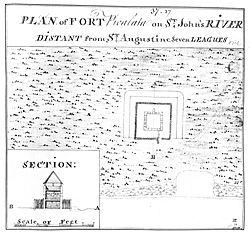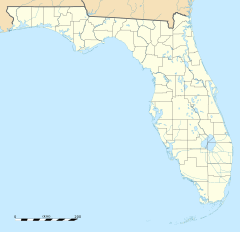Fort Picolata facts for kids
Quick facts for kids Fort Picolata |
|
|---|---|
| Northwest of St. Augustine, Florida, on east bank of the St. Johns River in United States | |

Plan of Fort Picalata on St. Johns River
|
|
|
Location of Fort Picolata
|
|
| Coordinates | 29°55′23″N 81°36′03″W / 29.92306°N 81.60083°W |
| Height | 32 ft. |
| Site information | |
| Condition | Only traces remain |
| Site history | |
| Built | 1734, rebuilt 155 |
| Built by | Spanish Army (Ejército de Tierra) |
| In use | 1740 |
| Materials | Originally pine log palisade and blockhouse, rebuilt with coquina shell rock |
| Events | Burned by Indian allies of James Oglethorpe's invasion force |
| Garrison information | |
| Garrison | Regular army troops |
Fort Picolata (Spanish: Fuerte Picolata) was an old Spanish fort from the 1700s. It was built on the east side of the St. Johns River in Florida. This spot was about 18 miles from St. Augustine, which was the main city of Spanish Florida back then.
The fort was located on an old trail that led to a Spanish area called Apalachee in western Florida. Fort Picolata and its partner fort, Fort San Francisco de Pupo, were very important. They controlled all the people and goods crossing the river where it became very narrow. This natural crossing was called "Salamatoto" by the local Native American tribes. The very first defenses at this location, built around 1700, were simple. They were just a small guard post surrounded by a wooden fence.
Contents
Building the Fort: A Spanish Defense
In the early 1700s, there was a lot of tension between the Spanish and the British. James Moore, who was the governor of Carolina, had attacked Spanish Florida in 1704 and 1706. Because of these attacks, the Spanish decided they needed better defenses.
So, in 1734, Governor Francisco del Moral y Sánchez ordered Fort Picolata to be built. Its partner fort, Fort San Francisco de Pupo, was built at the same time. These forts were meant to protect against more attacks from the English and their Native American allies.
Battles and Rebuilding
In late 1739 and early 1740, General Oglethorpe, the governor of the British Province of Georgia, invaded Florida. He brought with him Scottish Highlanders and Native American allies. During this invasion, the Native American allies captured and burned Fort Picolata. After this, Oglethorpe tried to take St. Augustine.
The Spanish rebuilt Fort Picolata in 1755. This time, they used a strong local rock called coquina (a type of shell rock). There are no records showing that Fort San Francisco de Pupo was rebuilt by the Spanish.
In a letter from January 31, 1740, Governor Montiano wrote to King Philip. He explained that Fort Picolata and Fort Pupo were built for a specific reason. They were there "solely for the purpose of defending and sheltering from the continual attacks of Indian allies of the English, the mails that go to and come from Apalachee." This means the forts protected mail carriers from attacks by Native Americans who were allied with the British.
British Control and Important Meetings
In 1763, the British took control of Florida after signing the Treaty of Paris. They quickly realized how important Fort Picolata was for defending St. Augustine. The British continued to keep soldiers at the fort, just like the Spanish had done.
Fort Picolata became a place for important meetings between British officials and Native American leaders. Two major meetings happened there in 1765 and 1767.
The Picolata Conference of 1765
The first Picolata Conference took place from November 15 to 18, 1765. British officials met with leaders from the Lower Creek and Seminole tribes. John Stuart, who was in charge of Native American affairs for the Southern Department, organized the meeting. Governor James Grant called for it.
The main goal was to agree on the borders between Native American lands and British lands. A treaty was signed at this meeting. Through this treaty, the Native Americans gave up over two million acres of land in northeast Florida to the British. This land stretched 35 miles west from the coast, and included all the coastal land on the rest of the peninsula, extending up to ten miles inland.
The famous American botanist and explorer John Bartram and his son William attended this conference.
Later Years and Bartram's Visit
In his book Travels, William Bartram wrote about visiting Fort Picolata in April 1774. He said he found it "dismantled and deserted." However, this was not entirely accurate. Bartram wrote his book 18 years after his visit, so he might have misremembered.
In a report he made in 1774 to his father's agent in England, Dr. John Fothergill, Bartram wrote something different. He said he had stopped "at Picolata Fort. which I observed was newly repared [sic]." This suggests the fort was actually in good condition and had been recently fixed up.



